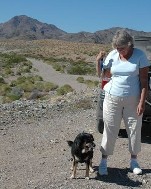Traditionally defined as a fibrous cryptocrystalline variety of Quartz, more recently, it has been shown that much Chalcedony is a mixture of Quartz and Moganite, another silica mineral.
 (Moganite - Formula: SiO2, System: Monoclinic, Colour: Grey, Hardness: 6, Name: After the type locality: Mogán, Grand Canary Island, Spain.)
(Moganite - Formula: SiO2, System: Monoclinic, Colour: Grey, Hardness: 6, Name: After the type locality: Mogán, Grand Canary Island, Spain.)Found as cryptocrystalline inclusions within a large number of quartz crystals.
When it is concentrically banded (often in rather wild patterns) it is called by the subvariety name Agate. When it is in flat layers/bands it is called by the subvariety name Onyx.
[Note: Many non-banded forms of chalcedony - such as Moss agate - are often erroneously called 'agates'. True agate is concentrically banded. Mottled and included chalcedonies are more properly called simply 'chalcedony.' Agatized wood is the name given to fossil wood where the replacement of the wood is by chalcedony, but the banding in this case is due to the wood structure - not concentric deposition of the chalcedony - and the material is chalcedony, not true agate.]
May be blue color because of the presence of Chrysocolla.
Formula: (Cu,Al)2H2Si2O5(OH)4·nH2O
System: Orthorhombic Colour: Green, bluish green, ...
Lustre: Vitreous,Waxy,Earthy Hardness: 2½ - 3½
Name: The name was first used by Theophrastus in 315 B.C. and comes from the Greek chrysos, meaning "gold," and kolla, meaning "glue," in allusion to the name of the material used to solder gold.
A mineral of secondary origin, commonly associated with other secondary copper minerals, it is typically found as glassy botryoidal or rounded masses or bubbly crusts, and as jackstraw mats of tiny acicular crystals or tufts of fibrous crystals. Copper-bearing allophane can look similar.
This could be known by another name, Azurite, Azurchalcedony. And is often found in association with Malachite in copper-bearing deposits.






No comments:
Post a Comment